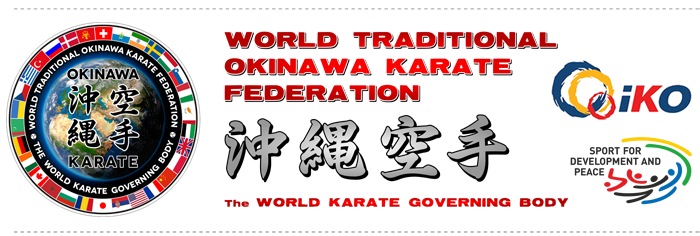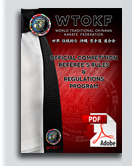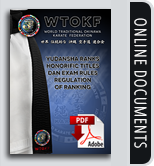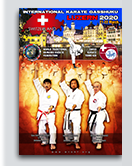 |
The History of Okinawa Karate
The Early Since antiquity Okinawa has been an all-around training ground for the creation of the most effective martial arts for the unarmed fighter. This martial art later became OKINAWA TE. In the expanses of a vast sea, halfway between the Chinese island of Taiwan and the Japanese island of Kuyshu, 800 kilometers from the continent lies a ring of small islands - the archipelago Ruyku(Nansei) - whose largest island Okinawa takes up almost half of its square surface of 2,5 thousand km2. The word "Okinawa" - literally means "rope on the horizon" and the shape of this bleak island really reminds one of a rope tied up in a knot. Relatively little was known about Okinawa right up to 1945 when the island became the center of heavy fighting between Japan and the U.S.A. at the end of the second world war. If you imagine Japan, Korea, Taiwan, and the Philippines in the shape of an open fan, then Okinawa always finds itself right in the center, which is why of late, even now that the war years have finally become something of the past, Okinawa has remained the largest American military base in South-East Asia, with the main reason being that Okinawa holds such an important strategic position. It now only takes a few hours to cover the distance between the continent (China) and Okinawa, whereas it used to take, using winds and currents, 3-5 nights to sail there. This explains the role of island of Okinawa.. The population of the archipelago, ethnically similar to the Japanese, have nevertheless kept their own ethnographic special character. Okinawans are neither Japanese nor Chinese and yet the real origins of the inhabitants' roots remains a mystery. The fact that Okinawa is located not far from China, is of great significance when we examine the source of its development. It is in view of this fact that ambassadors, merchants and monks traveled to continental China. The direct result of such an exchange being that Okinawans were introduced to different aspects of Chinese culture, which included martial arts. From ancient literary sources, in particular from Dadao Bitsi (Memoirs from the Large Island), it is known that relations between China and Okinawa began as early as the 6th century A.D. (period of the Soon Dynasty Empire) and reached their peak in the middle of the 15th century during the rule of the Okinawan Syo Dynasty. The evolution of martial arts on Okinawa took two different directions: Tsuan Fa (Chinese fighting system) and To De (Okinawa martial arts). However, in 1609 the relations between Okinawa and China from which Okinawa had gained rich economic and cultural benefit came to an end. The head of the south-Japanese Clan Satsuma, Shimatsu Iehitsa with the Japanese Emperor's permission, and three thousand Samurai armed with muskets on 100 worships captured Okinawa. This was the end of the Okinawa's independence and the beginning of a harsh subjugation of the Ruyku archipelago. In 1610 Shimatstu Iehitsa introduced a great number of prohibitions and laws. The population of Okinawa was heavily taxed and subjected to discrimination. However, one of prohibitions, in an unexpected way for the invaders, turned out to be a powerful stimulus for the development of Okinawa Te. It was a question of the ban on not only carrying, storage but also the possession of any kind of weapon as well as any practice of martial arts under threat of the death penalty. In regular skirmishes with Samurai armed not only with swords but also with fire-arms (Portuguese muskets) the Okinawan warriors sharpened their skills, instruction and training were carried out under the utmost secrecy. The official Japanese laws from this epoch stated: "Should a member of the lower class, such as a townsman or peasant, be guilty of insulting a Samurai, whether it be in word or in jest, he is to be sabered there and then". To these laws there was a perambulatory understanding - "Ta Mesi Giri" (sword test) giving the samurai the right to test his sword on the head of any commoner. Subsequently in skirmishes with Samurais the Okinawans acquired a formidable reputation forever stating the cardinal principle - "ikken hissatsu" (to kill with one blow). Okinawan martial arts masters secretly visited the continent and remained for years, learning the most effective styles, defeating he most famous Chinese fighters. The constant practical refinement of the fighting system, secrecy,and lawlessness became characteristics of Okinawa Te and remained a part thereof right up until the beginning of the 20th century, even though the official occupation by the Satsuma clan ended in 1875, when Okinawa was declared an integral part of Japan and Okinawans gained full civil rights freedoms. Under the Japanese government Meidsi (1867-1912), all of the country including Okinawa was mobilized. Medical examinations were conducted in schools and doctors were struck to see how sharply students practicing Okinawa Tai differed from other students in terms of physical preparation. Subsequently in 1901 in a pedagogical institute and in one of the schools of the city of Shuri, Okinawa Te was started being taught. Therefor, due to the history of its evolution Okinawa became a universal training ground for the development of the most effective martial art for the unarmed fighter. For hundreds of years this martial art evolved, was studied and perfected by an entire nation which had to fight the Japanese unarmed. There is now on Okinawa only one school for Ancient Okinawa Combat Karate and Kobudo - "Sindo Ryu" (its name can be translated as "The School of the Truthful Way") headed by the 68 year old Sensei Hanashiro Naito. What distinguishes the Sindo Ryu school from others, is that all fighting is full contact, no protective equipment is used and it takes place in accordance with Ancient Okinawa Combat Karate rule- "Uri Kumi Go", by which only the blows forbidden are ones to the eyes and any and all styles are permitted. Such is the Sindo Ryu method because only the most violent, most realistic bouts make it really possible to evaluate the effectiveness mastered during technical training sessions and to test the strength of fighters' spirit. In order to prevent injuries , Sindo Ryu Karate students undertake special preparation methods, which have been refined over hundreds of years, and which enable them, after one and a half -to two years training, to successfully participate in bouts without any detriment to their health. The methods of Okinawa Te are not widely practiced and are almost unknown even to martial arts experts, the reason simply being that they are the main riches of the esoteric system of this family school. The head of the school Hanashiro Naito tries in every way possible to hinder the promulgation of Okinawa Te, fearing a perversion of the style.
The history of the development of Ancient Okinawa Karate can be broken down into five main periods: Before 1372 Okinawa Te and Kobudo had already developed into a classical fighting system on Okinawa. By 1372 trading relations between Okinawa and China had already existed for several hundred years. That year something which would have an enormous impact on not only the development of Okinawa Te but also on the history of Okinawa itself happened. The Emperor of Okinawa Satto voluntarily agreed to become a vassal of China. Under Chinese laws of that time goods produced in countries belonging to China's protectorate were not liable to customs taxes. China was obliged to, in case of war, defend countries under its protectorate. A delegation of Okinawans signed the agreement in Peking with the Emperor Hang Wu Thai (Ming Dynasty). In 1393 an event called "Sanye Roku Sei" - "Thirty-six families" took place. A large group of Chinese settlers founded on Okinawa the village Kume Mupai not far from the city of Naha. The expression "Thirty-six" doesn't signify the number of settlers, but rather in the 15th century this Chinese character meant a large group of people. They had not come to wage war. Some of them were artists, craftsmen, and seafarers. They taught the Okinawans Chinese writing, education, and arts. Among them was also large group Tsuan Fa masters (Chinese Martial Art). Young people were more than happy to start learning a new type of martial art. It was right at this time that Tsuan Fa (Chinese Martial Art) and To De (Okinawan Martial Art) began to unite to create Ancient Okinawa Karate - a new martial art which had no equal. By 1600 the Ming Dynasty was in decline. China was invaded by Mongolian hordes. The head of the South-Japanese clan Satsuma, Iehitsu Shimatsu decided to take advantage of this situation. With the emperor's permission and three thousand Samurais armed with muskets on 100 warships, seized Okinawa. The Okinawan Emperor was disposed. A small group of people loyal to the Emperor openly resisted the Satsuma. They were captured and sentenced to death. Several enormous cauldrons water were placed on a bonfires and they were thrown into the boiling water alive. Okinawans who witnessed the execution created a symbol - three twisted drops in a circle which reminded them of the boiling water in the caldron boiling when a man was thrown in. "Hedari gomon " became the symbol of the fight of Okinawan inhabitants against Japanese Samurais and subsequently the symbol of Okinawa Te. In 1875 the official occupation by the Satsuma clan came to an end. Okinawa was recognized as an integral part of Japan and its inhabitants were granted full civil rights and freedoms. Subsequently it was at this time that Okinawa Te took on a more modern form. It was in 1936 in the city of Naha at a conference for the representatives of different styles and schools of Ancient Okinawa karate that the decision was taken to found the Okinawa Te Federation. Be that as it may they were very decided not to create one sole Okinawa Te karate style school but rather unite all the existing style and schools of classical Ancient Okinawa Karate. It was at this moment that began the modern history of Okinawa Te-a thousand year-old martial art incorporating the very best from two of the greatest branches of martial arts of all time. Regarding the splitted worldwide situation in the world of karate, the WORLD TRADITIONAL OKINAWA KARATE-DO FEDERATION considers that the only way to reunify the Karate is the promoting of the Okinawa Karate and promoting the concept of the Okinawa Karate which means following the japanese tradition and the respect for the japan traditional karate rules which assuming all the karate styles stricly respecting the rules of all styles in part which has the origin in Okinawa Karate. The politics of WTOKF for realizing a brotherhood with all the organisations and federations regardless of style worldwide - is the idea of unification of the karate worldwide once and forever. The WORLD TRADITIONAL OKINAWA KARATE-DO FEDERATION is open and remains open to any collaboration with any organization or federation regardless their style, with respect for Budo and the spirit that unites us all. We are counting on all organizations and federations around the world, of all practitioners of martial arts, to finally realize the dream of all karateka, that to karate to be recognized in the Olympic Games.
PRESIDENT
|











